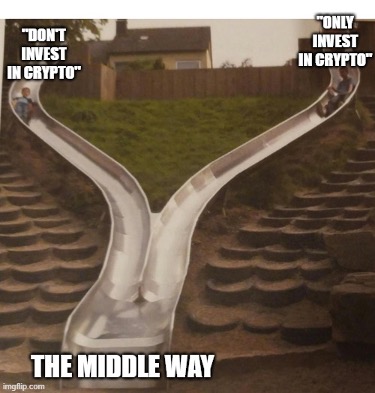
At Bitcoin Market Journal, we are different from other crypto sites in one important way: we share our investing results with you.
Since 2018, we’ve been reporting quarterly on the results of our Blockchain Believers Portfolio, comparing them with “Non Believers” who don’t hold crypto:
To our knowledge, we are the only crypto site that shares our long-term results.
Everyone else will hype the latest crypto token, and fill you with FOMO. We’ll tell you to avoid most of these crazy coins.
Everyone else focuses on short-term trading. We focus on long-term value investing.
Everyone else promises that you’ll get rich quick. Our approach is to get rich slowly.
With just a few simple rules that we’ll share below, we have crushed the results of traditional stock market investors over the last five years.
So, how have we delivered such superior results for our subscribers? Here’s our secret sauce.
Value Investing, Meet Crypto

You probably know the guy on the left: Warren Buffett, one of the most successful investors of our time.
But you may not know that cat on the right: That’s Benjamin Graham, the guy who taught Buffett how to invest.
Ben Graham’s classic book, The Intelligent Investor, is worth a read for anybody that wants to become financially independent. He invented what is today called “Value Investing,” and much of our work has been applying value investing principles to bitcoin and cryptos.
(We know, Warren Buffett famously hates bitcoin. We’ll change his mind.)
Using the time-tested principles of value investing developed by Graham and Buffett, here’s how to value the new world of digital assets. It’s value investing for crypto.
The Principles of Value Investing
Value investing in the traditional stock market revolves around investing in great businesses at a fair price. Successful value investors follow these principles, which we’re adapting to crypto.
Think like an owner: When you buy a stock, you are literally buying a piece of a business. When you buy $TSLA, you are a part-owner in the Tesla business. Ask yourself: is this business so great that you would buy the entire company, if you could?
As we’ve discussed in Our Approach, we view cryptos like “companies” and tokens like “shares.” (We put them in quotes, because they are different in many ways, but close enough for our purposes.)
Like evaluating a traditional company, we look at a crypto company and ask, is this a great business with great products, great financials, and a great management team? Do they have loyal customers? Are they profitable? Would we buy 100% of the business if we could?
Analyze rigorously: Traditional value investors evaluate and compare many businesses, using both quantitative and qualitative analysis (i.e., both numbers and judgment). You say “no” to most businesses, and a big “yes” to a few super-valuable ones.
Blockchain businesses are even better, because we can see the numbers in real time. We can count the “customers” of crypto companies. We can figure out the fundamentals. (See our guides to quantitative analysis and qualitative analysis.)
Our team spends a lot of time doing this fundamental analysis, which is how we pick a few big winners and avoid a lot of losers. You can use our free tools do this analysis yourself, or become a Premium Subscriber, where we’ve already analyzed all the top tokens.
Find stocks on sale: Value investors look for undervalued businesses, or at least they try not to overpay. In the words of Warren Buffett, look for “wonderful businesses purchased at fair prices.”
In the crypto world, this is a bigger challenge, because what’s considered “fair” is constantly evolving. Not too long ago, $600 would be a fair price for bitcoin. Then $6,000 seemed fair. As of this writing, we might call $60,000 fair.
Because crypto markets are still so young and volatile, when prices seem high, just wait a while: they’ll crash. Then you can buy at a steep discount. (Most people can’t bring themselves to buy when everyone else is selling, which is why our Steady-Drip method works well.)
Avoid losses: On the road to building crypto wealth, there are many hidden traps and dangerous cliffs. In most crypto circles, they’re rarely discussed. At Bitcoin Market Journal, we remind you of them again and again.
- We diversify our investments: this is why we invest primarily in stocks and bonds, with no more than 10% in crypto. We don’t put all our eggs in one basket.
- We avoid fees: despite its promises, crypto has way more fees than traditional finance, and these fees will eat up your wealth. (See our guide to Avoiding Fees.)
- We avoid YOLO-style gambles: it is tempting to follow the “degen” lifestyle, but just ask a degen to share their long-term results. (They won’t.)
- We practice good account security: we always know where our crypto is located, we use good password management, and we use common sense in sharing information.
- We HODL for the long term: every time we trade or cash out crypto, we get hit with a double whammy: taxes and fees. The solution is to hold for five years or more.
Think long-term: This last point is so important that we’ll repeat it. As value investors, we look to build wealth over a lifetime. We don’t think “get rich quick,” but “get rich and make it stick.”
The Middle Way
Today, the investing world is divided into two camps: “Don’t invest in crypto” and “Invest only in crypto.”
Fortunately, there’s a middle way.

This is the approach we’ve been patiently explaining since 2017, and that approach has paid handsomely.
Even while financial advisers told their clients to avoid crypto at all costs, even while crypto degens made and lost fortunes, we patiently preached the “Middle Way.” And it worked.
It’s not either traditional investing or crypto investing – it’s both!
Using this careful and responsible approach has allowed us to leave the stock market in the dust, by harnessing the explosive growth of crypto.
At the same time, keeping only a small percentage in crypto lets us sleep at night: even if bitcoin goes to zero, we’ve only lost 10% of our investments (or less).
It’s this “Middle Way” that has seemed so radical to so many, but which increasingly is just becoming common sense.
Because over the long term, the results will tell you who’s right.

